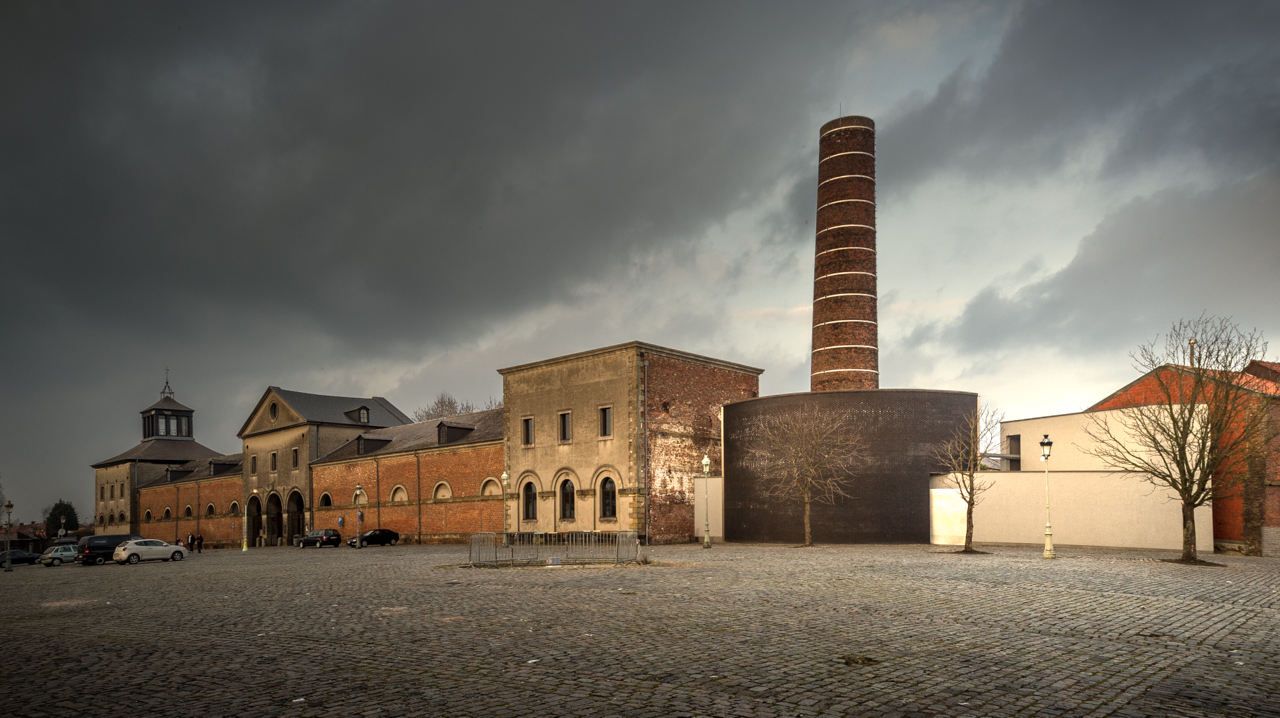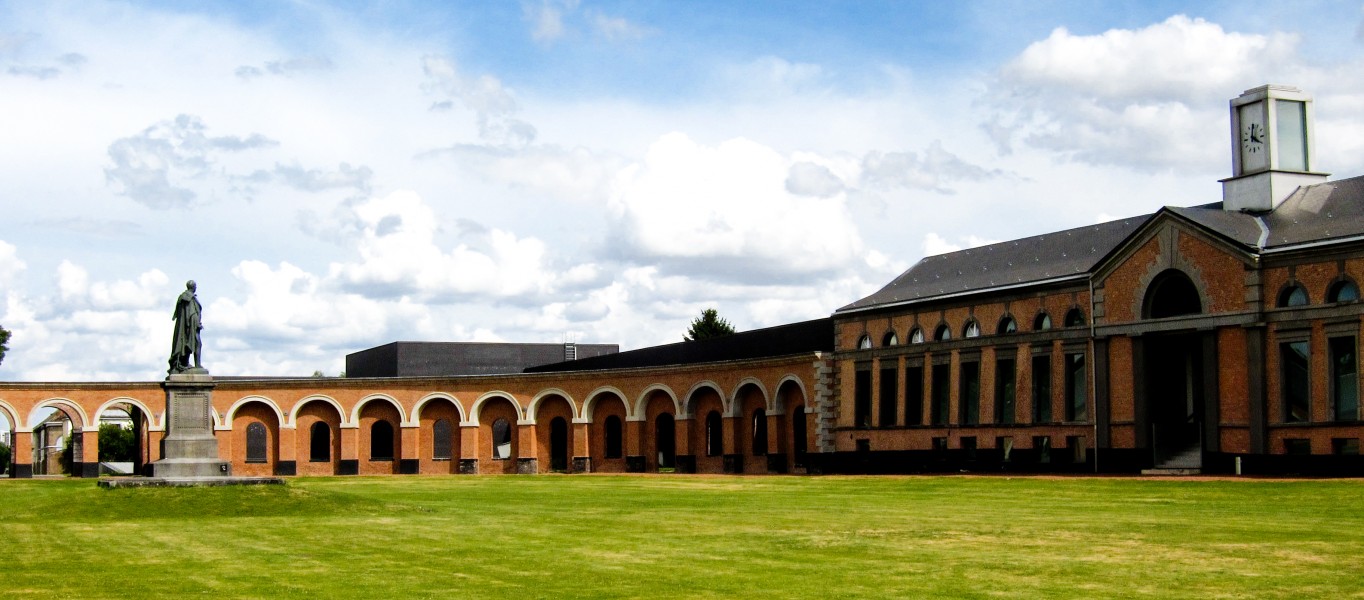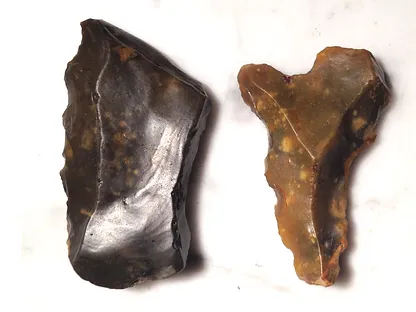July 1- 4, 2018
The landscape consists of rolling farmland and small woods. It has had an unbelievably turbulent history – a battleground for millennia. Mons was the European Capital of Culture in 2015.
I am not sure why the French here also speak zero English when the rest of Belgium is effectively bilingual. Unfortunately, the museums too are mostly in French. Wallonia feels like a totally different country, much more like France with Flanders much more like Holland. Compared to bicycle mad Flanders, you virtually never see a bicycle here except clubs out on mass rides, when they take up the whole road riding several abreast. The bicycle is certainly not part of daily life.
Gas. Avoid Q8 or Total, both are very expensive. It gets cheaper close to big cities. I found one associated with a large computer store west of Liége for €1.34 but that was very unusual as €1.38 is usually the cheapest. Oil is unbelievably expensive at over €20 per liter!!
Groceries. Avoid Carrefour or Markt, a Carrefour subsidiary, and try to keep to Aldi and Lidl, both inexpensive but without the most complete selection.
HAINAUT PROVINCE
TOURNAI (pop 70,000)
Even by local standards, the town has been in wars and occupied at various times by Romans (Tornacum), Franks (original 5th century capital of the Frankish Merovingian dynasty and then autonomous from the French in 1187), Normans, French, English (1513 conquered by Henry VIII and then sold back to France in 1519), , Austrians (Hapsburgs in 1521), Spanish (conquered in 1581), Dutch and Germans.
Tournai found renewed wealth from successively: tapestries, textiles and porcelain, but it was devastated by the WWII bombing. There is a lively bar and restaurant scene around the Grand Place, its gorgeous triangular main square.
Cathédrale Notre Dame. This Unesco WHS (1936) cathedral has a storied history: it was built on 5 previous churches exposed in 2018 – the entire north aisle was a large archaeological dig when I was there. A fire caused the present building to be built in 1000-1070; the transept with its great central 45m steeple surrounded by 4 completely different towers in 1150-1158; Gothic choir in 1255; rose window in 1861; all the stained glass was destroyed when a dynamite magazine exploded; it survived WWII bombs and then had a freak 1999 tornado that compromised its stability. It is 134m long. The entire area from the choir on was closed with a mass of scaffolding when I was there. The slate roof was being replaced with a lead one requiring 700 tons of lead.
The austere interior had several grave slabs, a magnificent wood pulpit and a wonderful carved stucco rood screen. Free, €2.50 to visit the Treasury.
Musée des Beaux-Arts. This airy gallery was designed by art-nouveau maestro Victor Horta and is one of the very first prototypes of a modern museum in the world. I liked the collection including Tornai’s best-known artist Rogier Van der Weyden and works by Rubens, Manet, Monet, Seurat, Van Gogh, and Toulouse-Lautrec. Free on Sundays
Ath. In the NM small town series, it is on the Unesco Living Heritage list, On August 4th, Ath’s giants walk through the square in the annual festival. L’eglise Saint-Martin dates from the 19th century. It has a covered Crucifixion scene with a 1675 – 6.7 Christ flanked by the two thieves, one with a gargoyle face and fronted by statues of the Virgin Mary and St John the Baptist. The clock dates from the 16th century. Inside is a 1585 entombment scene in a glass showcase. On the other side of the square is St-Julian Church with a massive bell tower. There is no belfry. The parking lot in the square was full as were the restaurants.
Aubechies. This NM small town was a mystery – a tiny collection of dairy farms on the highway with no church, belfry, or business. Go figure.
Boloeil Chateau. The princes “de Ligne” dynasty has inhabited this site since 1394 – 30 generations of lords, ambassadors, senators, warlords, and writers. The chateau is completely moated and sits beside a 6-hectare lake on 25 hectares of lawn and a forest of rare trees. Inside are paintings, furniture, dishes, statues, and a library with 20,000 books.
MAJOR MINING SITES of WALLONIA
During the Industrial Revolution in the 19th century, mining and the heavy industry that relied on coal formed a major part of Belgium’s economy. These 4 sites were recognized by the UNESCO commission in 2012.
The four sites of the property form a strip in the Walloon Coal Basin (the French-speaking provinces of Hainaut and Liège) 170 km long by 3–15 km wide, crossing Belgium from east to west and consisting of the best-preserved 19th- and 20th-century coal-mining sites of the country, both surface, and underground.
The four sites include numerous technical and industrial remains, relating to the industrial architecture associated with the mines, worker housing, mining town urban planning, and the social and human values associated with their history – testimony to the early dissemination of the technical, social and urban architecture of the industrial revolution.
While Wallonia had hundreds of collieries, most have lost their infrastructure, while the four components of the listed site retain a high measure of integrity. Finally, they are one of the most important sites of interculturalism arising out of mass industry through the participation of workers from other regions of Belgium, Europe, and later Africa.
1. Grand-Hornu in Hornu, Hainaut, colliery and workers’ city designed by Bruno Renard in the first half of the 19th century. It is one of the first examples of town planning and is one of the world’s oldest company towns.
2. Bois-du-Luc in Houdeng and Amerais, Hainaut Province. One of the oldest coal mines in Belgium (dating back to the late 17th century), it closed in 1973. There are numerous buildings erected from 1838 to 1909 preserved as an ecomuseum, the site is best known as a company town.
3. Bois du Cazier, Marcinelle, Hainaut Province. A coal mine from 1822 to 1967, the Bois du Cazier is best known as the site of a major mining disaster in 1956 when 262 miners, many of them Italian migrant workers, were killed.
4. Blegny-Mine, Biegny, Leige Province. A major coal mine in eastern Belgium, it was the last to close in the province in 1980.
The mining sector in Belgium declined during the 20th century during deindustrialization and today the four mines listed are no longer operational. Each an important part of Belgian industrial heritage and is open to visitors as museums.
GREAT HORNU
About 5kms west of Mons, this is one of the most beautiful architectural complexes dating from the industrial revolution. It is a former colliery built between 1810 and 1830 by the French industrialist, Henri de Gorge. He employed the architect Bruno Renard to design the urban plan: neoclassical offices, the Chateau de George, colliery workshops, 450 miner’s residences (each with its own private garden and exceptional comfort for the time), school, hospital, public squares, library, and a dance hall. In the mine, De Gorge pioneered new extraction techniques using steam engines, and the first horse-drawn railway in the country.
The site was abandoned in 1960 and allowed to disintegrate. It was purchased in 1971 by an architect who established his offices there. The Provincial government purchased the site in 1989 and finished the renovation, then proceeded to promote heritage, culture, tourism and contemporary design. In 2002, the Museum of Contemporary Art was established. In August 2012, along with the other three coal collieries, was granted UNESCO World Heritage Status.
There was a fascinating display of innovative collective housing schemes from all over the world. Impeccable models showed communal apartment complexes in Berlin, Tokyo, Vienna, Zurich, and others.
MONS (pop 94,000)
The European Capital of Culture in 2015 when several museums were built, it has a medieval center through the Grand Place. Since 1997, Mons has been home to NATO Command-operations headquarters.
Mons Memorial Museum. Covers Mons experience of the two world wars.
Musée Francois Duesborg. Exotic gilded clocks, dazzling porcelain, and silver coffee pots from 1775-1825.
NEOLITHIC FLINT MINES AT SPIENNES
These cover more than 100 ha on two chalk plateaus, located close to the Walloon village of Spiennes, 4 miles southeast of Mons, Belgium. They are the largest and earliest concentration of ancient mines in Europe active during the mid and late Neolithic between 4,300 and 2,200 BC. They were inducted into the UNESCO’s list of World Heritage Sites in 2000.
The site is now devoted to agriculture and appears on the surface as a large area of meadows and fields strewn with millions of scraps of worked flint, material that was essential for the production of tools and cultural evolution generally. They demonstrate a seminal stage of human inventiveness, technological and cultural application and progress, the transition between opencast and underground mining.
Underground, the site is an immense network of galleries and caverns linked to the surface by vertical shafts. Different techniques were used, the most characteristic was the digging of shafts of 0.8 to 1.20m in diameter with a depth down to 16m. Neolithic populations could thus pass below levels made up of large blocks of flint (up to 2m in length) that they then extracted using a particular technique called ‘striking’ (freeing from below with support of a central chalk wall, shoring up of the block, removal of the wall, removal of the props and lowering of the block).
The density of the shafts is important, as many as 5,000 in the zone called Petit Spiennes (14 ha), leading to crisscrossing of pits and shafts in some sectors.
Stone-working workshops were associated with these mining shafts as is witnessed by numerous fragments of flint still present on the surface and which give its name to a part of the site, Camp à Cayaux (Stone Field). The large slabs of flint weighed up to hundreds of kilos and the nodules were extracted using flint picks. The stones were then knapped into rough-out shapes of axes and finally polished to achieve the final state. Essentially the production aimed at the manufacture of axes to fell trees and long blades to be transformed into tools. The standardization of the production bears witness to the highly skilled craftsmanship of the stone-cutters. The vestiges of a fortified camp have also been discovered at the site comprising two irregular concentric pits at a distance of 5 to 10m. The archaeological artifacts discovered are characteristic of the Michelsberg culture discovered in the mining sector.
The rough-outs were exchanged over a wide area, about 150 km (93 mi), and were often polished at their destination. Polishing strengthens the final product, making the ax- or adze-head last longer. The smooth surface also aids the cutting action by lowering friction with the wood. The axes were used initially for forest clearance during the Neolithic period, and for shaping wood for structural applications, such as timber for huts and canoes.
Similar sites. The site has been compared with Grimes Graves and Cissbury in the United Kingdom, and Krzemionki in Poland, which are also sources of flintstone.
Neolithic Flint Museum SILEX. Drive through the village of Spiennes and follow the signs to Silex. The narrow paved road turns onto the gravel in a rural area between potato fields. Silex is a large metal round museum complex built over two shafts that connect to a large cavern in the chalk soil. There is nothing to see around the museum. Visit the open mining areas at Camp-à-Cayaux east of the town.
STRÉPY-THREU BOAT LIFT
On the Canal du Centre, this is one of three boat lifts that replace locks. The one here is the world’s highest raising boat 73 meters. It cost €150 million. A massive 27m wide column has long boat basins on either side supported by 72 steel cables that do the lifting. The whole structure is topped by a massive black glass building. Unfortunately, no boats were using the lift when I was there. This is a UNESCO WHS.
The two other lifts downstream are the Ascensor Hydrolique and the Plan Incliné (at Ronquiéres), a 1.4km long slope, or ‘sliding lock, it oddly lowers boats down a steepish gradient in a giant bathtub). €6.50 concession
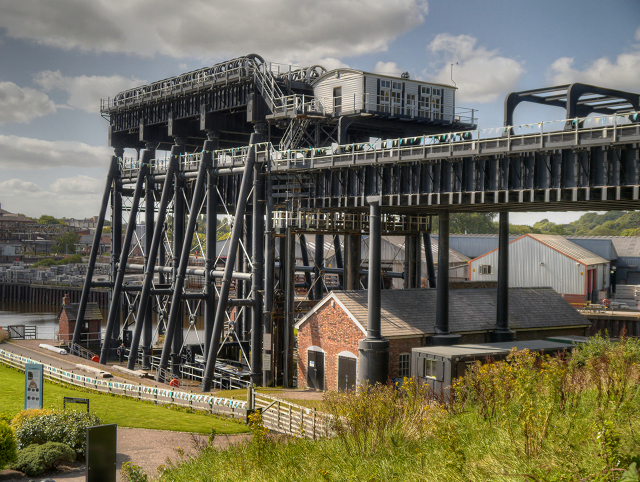
Ascensor Hydrolique

Plan Inclinè
La Louvière. An NM European city, this was a nondescript place with no architecture to speak of.
Chateau de Steffe. Built by Paris financiers, the Chateau sits on 22 hectares of parkland dating from 1760 containing an ornamental lake, huge trees, hedges, and gardens. The 80-meter square courtyard is flanked by colonnaded galleries with an octagonal dome on each end. In the courtyard are wonderful sculptures by Felix Roulin – round and square polished steel columns broken up by black human body segments. The blue-stone chateau has nice parquet floors, furniture, and stucco ceilings.
I slept overnight at a large truck stop, really just a pull-over on the side of a freeway. I talked for a long time to a Dutch driver and learned all about his state-of-the-art Volvo truck equipped with everything imaginable including 220 electricity, a refrigerator, microwave, and two beds. Amazingly despite all the vehicles using this space, there was no bathroom or water.
After almost a month of no rain, there was a large thunderstorm with torrential rain today (July 3).
CHARLEROI (pop 205,000)
Until the 1960s, coal from here drove the Belgium economy, but now the main reason to come is for budget flights from its international airport. I came to see some of its museums.
Musée de la Photographié. Supposedly one of Europe’s biggest and most impressive photographic museums, the collection shows historic, contemporary and artistic prints. Upstairs is an area dealing with airbrushing, tricks of the trade, and illusions. Most labels are in French. My impression was not that great – there were a tremendous number of old photographs but little that was modern and none of the great portrait photographers like Annie Liebovitz or war correspondents.
The very first photograph was taken in 1826 and required a one-day exposure. In 1939, daguerrotypes were the first real photographs. In 1950, Talbot developed the negative-positive process and in 1889, Kodak produced the first mass-produced cameras. €7 concession
Museum of Glass. In an industrial complex south of Charleroi, this museum shows everything one would want to know about glass, but unfortunately no active production. €8 concession
Corroy-le-Château. This is a hard place to find as Google Maps didn’t come close. From the church in the center of Sombrelle head east and it is through a big stone gate on the left. In thick private woodlands, this castle has 3 round towers. Enter the courtyard to see the two-story chateau. It is only open on weekends but I looked through all the windows to see the furniture, paintings, and threadbare carpets.
After seeing the east part of East Wallonia, I turned south of Brussels on July 8 to see Waterloo before going to Brussels.
WATERLOO BATTLEFIELD
Tourists have been coming to Waterloo ever since Napoleon’s 1815 defeat, a seminal event in European history. at the site of the battlefield – actually many fields – a vast patchwork of cropland dotted with memorials and historically meaningful buildings. The area is just south of Brussels.
The main battlefield is known as Hameau du Lion (Lion Hamlet) some 5kms south of central Waterloo town.
History. After a disastrous invasion of Russia and the 1813 loss at Leipzig, Napoleon Bonaparte was imprisoned on the Island of Elba, Yet on March 1, 1815, he escaped, landed in southern France, and with remarkable speed managed to muster a huge army. The European powers promptly declared war and choose Brussels as the point at which to form a combined army. However, in those pre-rail days, that could take weeks and Napoleon knew that time was of the essence. If he could meet either army individually, Napoleon’s 124,000 men would outnumber roughly 106,000 Anglo-Dutch-Hanoverian troops or 117,000 Prussians. But he had to strike fast before the two combined.
On June 16, Napoleon struck the Prussians at Ligny, where Bûcher, the Prussian commander, was wounded and the Prussian army appeared to have been put to flight. Napoleon then turned his attention to British commander Wellington, whose forces were assembling at Waterloo, a carefully chose defensive position just south of Brussels.
The planned sunrise attack on June 18th was delayed because of soggy ground, and a midmorning, the French attacked Hougourmont farm, vital for the defense of Wellington’s rights. It fatally slowed Napoleon’s game plan. The Prussians had regrouped by 1 pm and the battle at Plancenoit deprived Napoleon of vital men on the main battlefield. At 2 pm, a massive wave of French infantry marched on Wellington’s left flank but thousands of Allied musketeers, hidden in ridgetop hedge, unleashed volleys of musket fire into the close-knit French formations. After this debacle, the French cavalry charged Wellington’s center, but the infantrymen formed defensive squares and used their bayonets into impenetrable spikes. As the Prussians were approaching, the elite Imperial Guards made a desperate attempt to break through the center through mud churned up by the cavalry and the soldiers were mown down from their protected high ground.
Around 8:15 pm, Wellington led a full-scale advance, the French fell into a full retreat, and Napoleon fled abandoning his carriage at Genappe with its cache of diamonds. He abdicated a week later and spent the rest of his life in exile on St Helena.
Hameau du Lion
Memorial 1815. The event’s bicentenary saw the construction of this new showcase underground museum. There is a great deal of information on the background of Napoleon’s rise especially the 1789 French Revolution, fills in information on key incidents, and then describes the make-up of the forces of each side. The included audio guide gives a lot of detail. After all the explanation, watch a 4-D movie of the battle in a theatre, then a virtual reality recreation. €14 concession for the local sights. These sites are part of a tentative WHS application.
Panorama. This is an old-fashioned 1912 Panorama de la Bataille, a circular action-packed painting of the battle scene. It is viewed from inside with the foreground littered with helmets, fences, dead horses, and the odd corpse and a soundtrack.
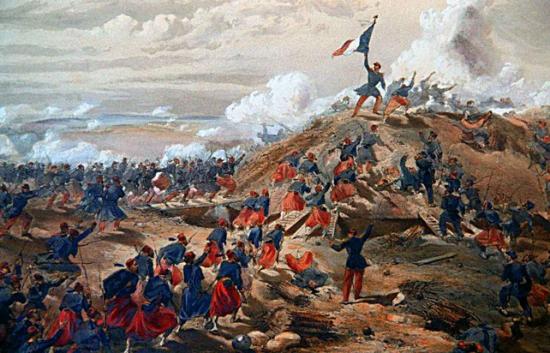
Butte du Lion. This steep, grassy cone topped by a massive bronze lion was built to commemorate William of Orange wounded on this spot – it took 2 years for women to carry up the soil in baskets. It is now 225 steps to the top to survey the battlefield’s deceptively minor undulations.

